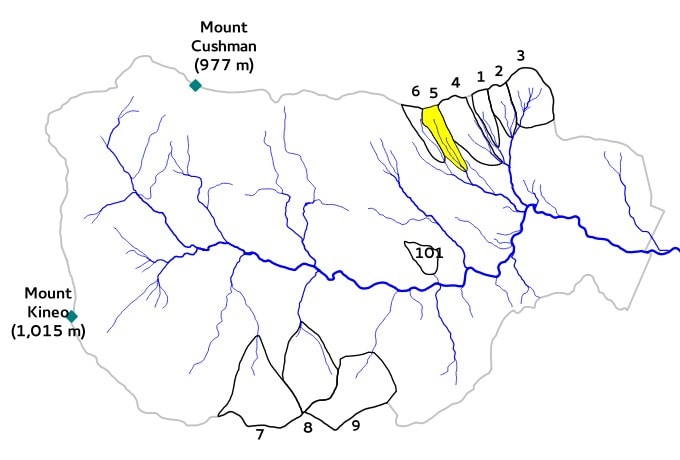Watershed 5
Area: 21.9 ha
Slope: 15.4°
Aspect: S24°E
Elevation: 488-762 m
Gage type: V-notch weir, San Dimas flume
Initial year: 1962

Description: A commercial whole-tree harvest was carried out on W5, a management practice that is regaining interest due to rising demand for biofuels. Compared to conventional stem-only harvests, whole-tree harvesting involves the removal of most of the above-ground biomass (boles and branches), raising concerns about nutrient removals and impacts on site productivity. In this application, all trees greater than 5 cm d.b.h. were cut with chain-saws and a track-mounted feller buncher equipped with hydraulic shears. Trees were harvested and removed from the watershed between October 1983 and January 1984, at which time there was a machine accident, leaving the upper one-third of the watershed uncut. Trees from most of the upper portion of the watershed were removed during the following summer. Felled trees in one small area (~12% of the watershed) were not removed until 1985, and about 3% of the watershed was inaccessible and remained uncut. In this treatment, no buffer of trees was left along the stream channel.
Treatment:
A whole-tree harvest was conducted during the dormant season of 1983-1984 resulting in the removal of 180 t/ha of biomass.
Prior to treatment, the watershed was surveyed into 360 25 x 25 meter plots to be used for research.
Objective: To assess the ecosystem response to whole-tree harvest.
Resulting Observations:
An increase in temperature (as much as 6°C) at the soil surface and in streams, unless streamside buffers of trees are left.
An increase in moisture content of the soil.
A maximum increase in streamflow of approximately 40 percent, and an increase in summer peak flows averaging 20 percent.
An increase in nitrification.
An increase of nutrients, especially nitrate, in soil solution subject to leaching loss or uptake by plants and microorganisms.
No appreciable increase in erosion and sedimentation.
Rapid decomposition and fragmentation of slash (75 to 80 percent breakdown in the first 14 years).
Rapid growth of pin cherry and raspberry from seed which had remained viable in the soil for decades; these pioneer plants conserve nutrients that otherwise might be leached from the site.
Baseline and Initial Results
Watershed 5 sampling grid
Continued research/treatment: Monitor changes in water yield and stream chemistry.
Datasets:
• Daily streamflow
• Streamwater chemistry
• Sediment yield in weir basin
• Phenology measurements
• W5 continuous revegetation survey
• Fine litterfall
• Coarse litterfall
• Throughfall
• W5 quantitative pit soil C and N
